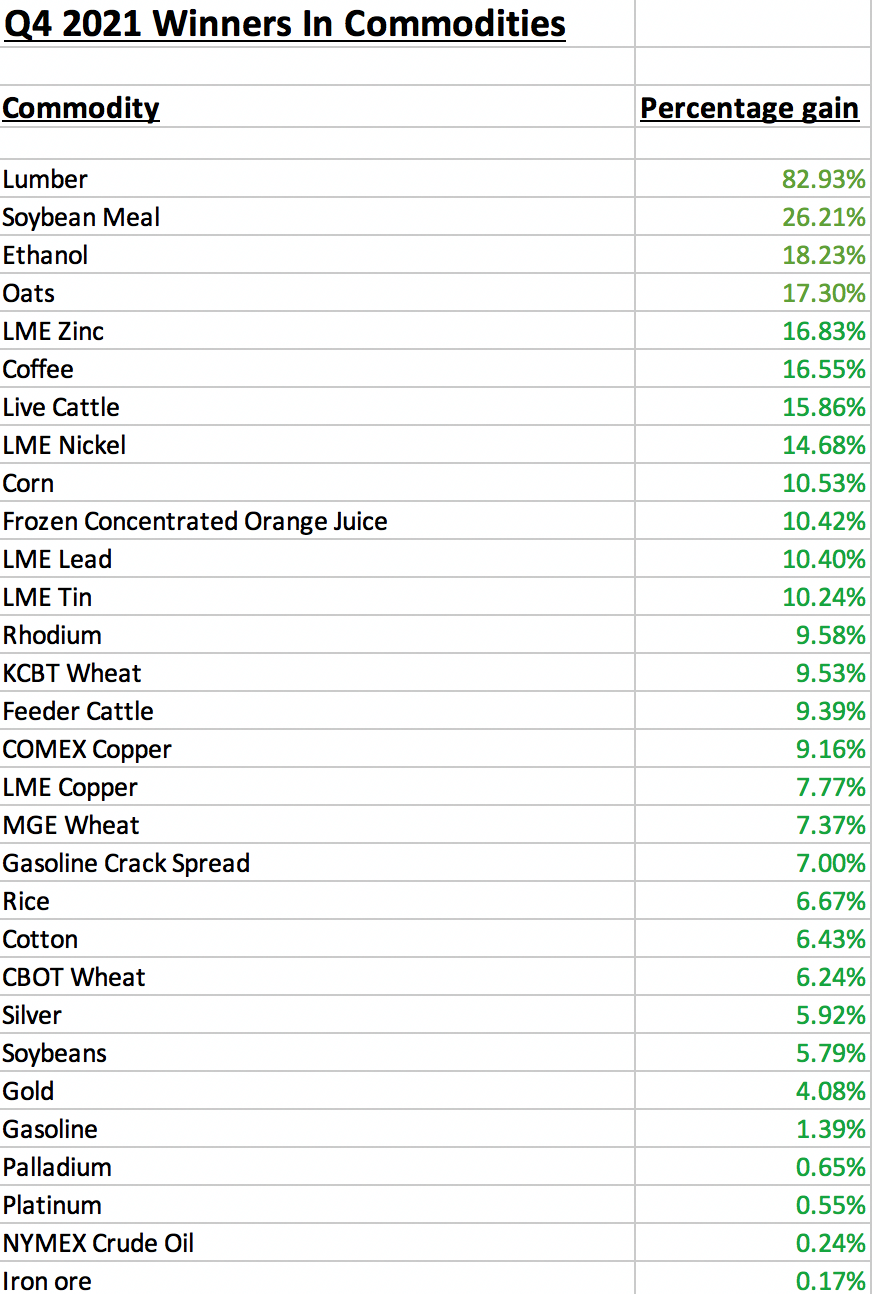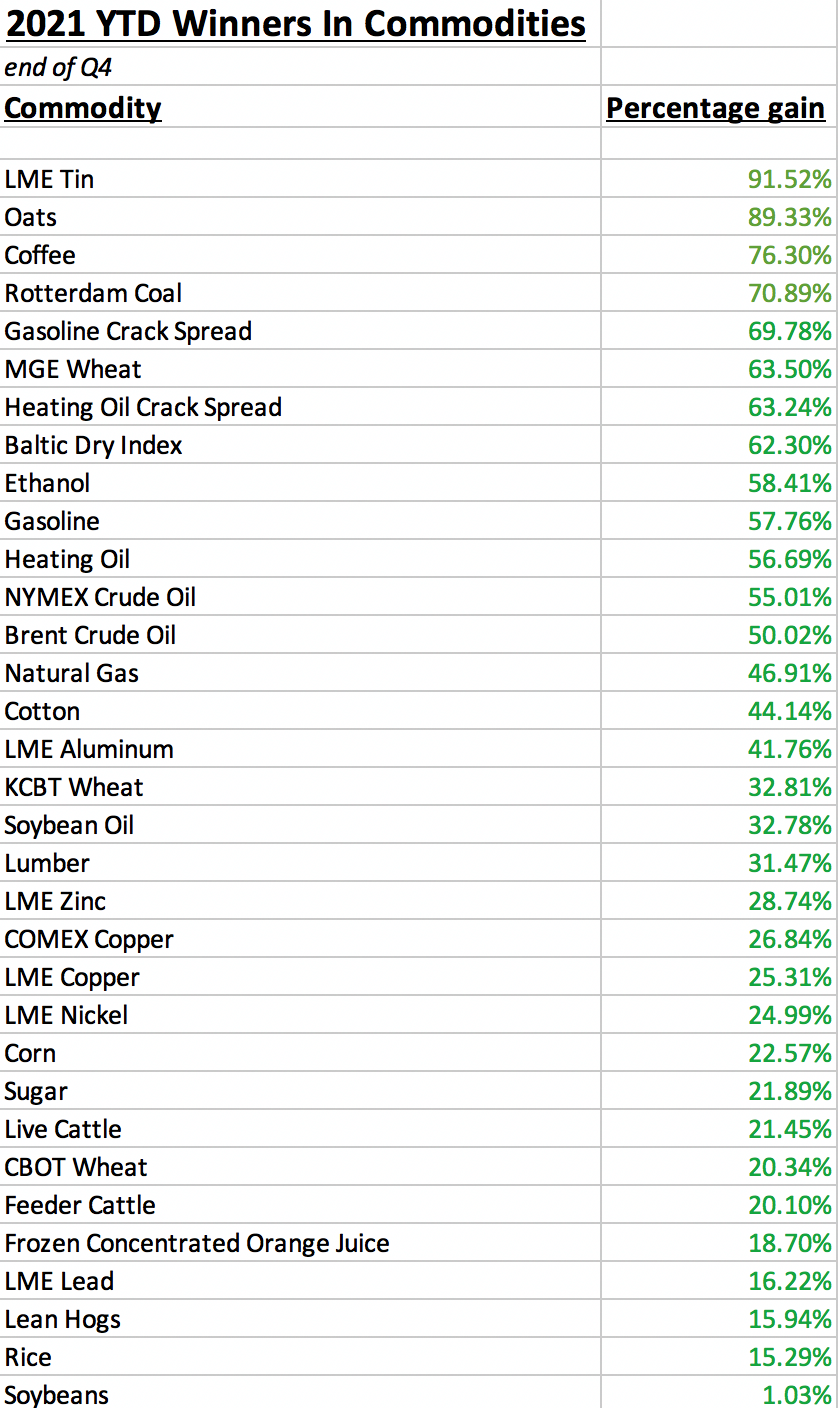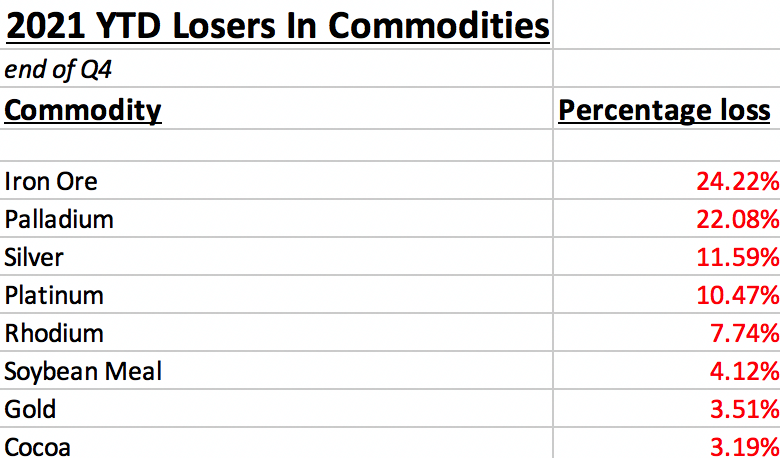This article was written exclusively for Investing.com
- The winners in Q4
- The losers in 2021’s final quarter
- The winners since the end of 2020
- Some commodities declined in the year that ended on Dec. 31, 2021
- 3 reasons for the rally - 3 reasons it will continue in 2022
The global pandemic pushed commodity prices to multi-year lows in 2020, setting the stage for a spectacular comeback and rallies in 2021. Most commodity prices rose in the year that ended last week, but some laggards declined on a year-by-year basis.
The central bank liquidity and government stimulus programs worldwide that stabilized the global economy lit a bullish fuse in the commodities asset class. The US Fed spent months calling inflationary pressures “transitory,” blaming the economic condition on pandemic-related supply chain bottlenecks.
At the December FOMC meeting, the world’s leading central bank finally threw in the towel and retired the term, indicating that inflation is an increasing structural issue that requires a more hawkish approach to monetary policy. Commodity prices spent 2021 screaming at the central bank that finally woke up at its final gathering. Meanwhile, economist Mohamed El Erian recently called “transitory” the Fed’s worst call in history.
Most commodity prices rose in 2021 and continued to exhibit bullish trends at the end of the year. The trend is always your best friend in markets, and will likely continue in 2022.
Winners In Q4
Thirty of 41 of the leading commodities posted gains in 2021’s final quarter. 
Source: Exchange Settlement Prices
The illiquid lumber market led the way on the upside with a nearly 83% gain over the three months. Twelve commodities posted double-digit percentage gains in Q4.
Losers In 2021’s Final Quarter
Eleven commodities posted losses from Sept. 30 through Dec. 31, 2021.

Source: Exchange Settlement Prices
The Baltic Dry Index (BDI) that monitors freight rates fell during the winter months for shipping. However, the BDI reached the highest price in many years in 2021 and was still higher than the price at the end of 2020 on Dec. 31.
Coal was the second-worst performer with an over 46% decline, but coal prices reached an all-time high in October before turning lower. Natural gas rallied to $6.466 per MMBtu in October, the highest price since February 2014, before turning lower and falling by over 36% for the quarter.
Ironically, except for cocoa, all commodities that declined in Q4 posted gains in 2021. Ten of the eleven all posted double-digit percentage gains for the year.
Winners Since End Of 2020
In 2021, thirty-three commodities posted gains, while there were only eight losers for the year.

Source: Exchange Settlement Prices
LME Tin and Oats led the way higher. Both markets suffer from illiquidity, which tends to exacerbate price moves. Thirty-two commodities posted double-digit percentage gains, with thirteen gaining over 50% for the year.
Some Commodities Declined In Year That Ended Dec. 31, 2021
There were four double-digit percentage losers in 2021 out of eight commodities that fell since the end of 2020.

Source: Exchange Settlement Prices
Iron ore was the top loser, but the price had gained over 72% in 2020. Precious metals prices moved lower, with losses in palladium, silver, platinum, rhodium, and gold in 2021, after all of the metals posted impressive gains in 2020. Soybean meal was over 43% higher in 2020, while cocoa posted a marginal 2.24% gain in 2020.
The bottom line is the price action in the commodities asset class was highly bullish in 2021. A composite of the 29 leading and most liquid commodities that trade on the US and UK futures and forward exchanges moved 4.73% higher in Q4 and 26.79% higher in 2021.
3 Reasons For Rally - 3 Reasons It Will Continue In 2022
Following the 2008 global financial crisis, central banks and governments provided liquidity and stimulus to stabilize the economy. The stabilization tools led to a commodity rally that lasted until 2011-2012.
While the 2020 global pandemic was a far different event, the tools were the same. The only difference was the liquidity tidal wave, and stimulus tsunami, was far greater in 2020 and 2021 than in 2008 and 2009.
Albert Einstein said that insanity is doing the same thing repeatedly and expecting a different result. Three factors, aside from the 2008 versus 2020 comparison, support higher commodity prices in 2022:
- Inflation remains a clear and present danger in 2022.
- The Fed forecasts a 0.90% Fed Funds rate in 2022 and a 1.6% rate in 2023. Even if inflation recedes, interest rates will remain in negative territory for the coming year.
- The trend is always your best friend in markets. At the beginning of 2022, the raw materials asset class trend remains bullish.
The ascent of commodity prices has been a bullish relay race, with one commodity handing the bullish torch to another since the early 2020 lows. Bull markets rarely move in straight lines, and corrections can be brutal, as we witnessed in many commodities this year. Lumber fell from over $1,700 per 1,000 board feet in May 2021 to below $500 in August. Copper declined from nearly $4.90 to under $4 over the same period. NYMEX crude oil fell from over $85 in October 2021 to below $63 per barrel in early December. A host of other commodities corrected, but none have come anywhere near the 2020 lows.
I expect higher lows and higher highs in the asset class to continue in 2022. Buying on price weakness will likely be the optimal approach as inflationary pressures are not going away anytime soon.
